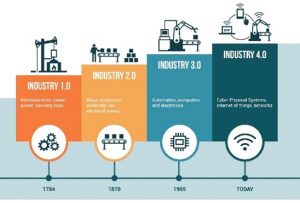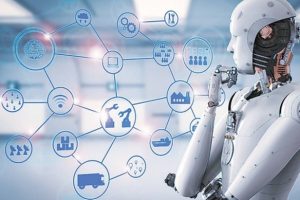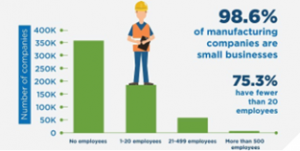My last article, “Where Do We Go from Here,” discussed the challenges of competing in a world market, particularly when it comes to competition for low cost. Low-skilled labor.
The US can’t compete with countries where the average worker compensation is less than half the compensation levels in the US. In order to make the US more competitive, our workforce must be used for activities of higher value. As discussed, technologies such as automation (Industry 3.0, beginning circa 1969) and the internet of things (Industry 4.0, currently gaining traction) are going to be key to survival. This article is intended to expand on these thoughts as I have received comments from some readers that they felt left hanging at the end of the previous editorial.
Implementation of Industry 4.0 and Impact on the Workforce
Even after the explanation of labor changes and additional training that will be required for the manufacturing workforce, some readers still express concern that Industry 4.0, building on the automation that began with Industry 3.0, is a job killer. Indeed, when this technology is expanded, lower skilled jobs will be replaced with machines. This will result in the elimination of jobs where workers are required to do mundane and repetitive tasks. As the technology develops, the goal is to reduce manufacturing costs to be competitive with ultra-low-cost labor in foreign countries rather than moving the work to those countries. This will require a workforce that is more skilled than the current workers to maintain and set up the machines.
 However, as Industry 4.0 comes along, machine learning and artificial intelligence will also change the job descriptions of the local workforce. Again, the intent is not to eliminate opportunities for workers, but to change the value equation and job descriptions to higher-value work. The days of manufacturing where unskilled labor is used to complete repetitive and mundane tasks, tasks that require little to no training, will be over. To participate in the manufacturing world, workers will need to have advanced training and opportunities to learn as apprentices under knowledgeable workers.
However, as Industry 4.0 comes along, machine learning and artificial intelligence will also change the job descriptions of the local workforce. Again, the intent is not to eliminate opportunities for workers, but to change the value equation and job descriptions to higher-value work. The days of manufacturing where unskilled labor is used to complete repetitive and mundane tasks, tasks that require little to no training, will be over. To participate in the manufacturing world, workers will need to have advanced training and opportunities to learn as apprentices under knowledgeable workers.
Challenges of Implementing Industry 4.0
At present, even though discussions and implementations began in 2008, the internet of things is still in its infancy. As technology for machine learning and artificial intelligence continues to evolve and develop, so do the challenges of implementing the technology. Concerns include the following:
- Development of protocols and standards between machines manufactured by various companies
- Cyber security of linked systems, particularly those tied to the internet
- Educational programs in technical colleges and universities for training the incoming workforce
- Cost of implementation for smaller businesses and manufacturers (98.6% of all manufacturing businesses are small businesses [1])
Some of these challenges may be more easily solved than others. For example, educational institutions like the technical college systems are eager to provide training for industry needs. In the last 12 months, Intel launched a pilot program it calls the “AI for Workforce Program,” which the company describes as “empowering students with necessary Artificial Intelligence skills for employability for the digital age.”
industry needs. In the last 12 months, Intel launched a pilot program it calls the “AI for Workforce Program,” which the company describes as “empowering students with necessary Artificial Intelligence skills for employability for the digital age.”
[2] The Thomas Industry Update reported that a survey completed by Intel found that only 45% of the educators surveyed in higher education institutions say AI-specific content is offered at their institution, but 69% of those surveyed believed that there is an increasing demand for such skills. [2] Clearly, the education system will need to prepare and be ready for the demands of industry. After all, development of an employable workforce is a key measure for the success of these institutions. However, these institutions need support from industry, including a “pull” for trained students. Industry must also decide and settle on the training that is needed. Unfortunately, settling on standards and protocols often proves even harder than implementing them.
 There are geopolitical entities and large businesses working to define standards and protocols to implement the industrial internet of things. Unfortunately, there does not appear to be a concerted effort by technical societies to define an international standard. Or maybe more appropriately, it might be said that technical societies have not received the support they need from industry in order to define a standard.
There are geopolitical entities and large businesses working to define standards and protocols to implement the industrial internet of things. Unfortunately, there does not appear to be a concerted effort by technical societies to define an international standard. Or maybe more appropriately, it might be said that technical societies have not received the support they need from industry in order to define a standard.
After all, much like the differences between CAD and PLC systems, there is money to be made in proprietary technologies. Perhaps the development will eventually go the way of the VHS versus Betamax competition. Perhaps one company will develop a standard that is eventually adopted by all users. However, that scenario would be painful and is unlikely. In that case, we may end up with several proprietary solutions that will compete and fracture the market.
Small businesses feed larger businesses. To become as efficient as possible, some version of Industry 4.0 will need to be available to keep those businesses competitive. When I think of the engineering and manufacturing services offered by KTM Solutions, we are most often contracted for work that can’t be outsourced to lower-cost providers. If the work is easily outsourced overseas, our labor rates can’t compare. For example, when we have competed head-to-head with Indian companies for work in the aerospace sector, we found that the fully burdened labor rate for an engineer located in Bangalore was less than what we pay our technical designers! That’s why our engineering team had to focus on the higher-value work. Being able to increase the worker value inside our manufacturing will be key, even for small businesses, particularly as labor rates increase.
For the manufacturing business community, our world is continually evolving. Competition gives birth to opportunity. We cannot stay where we are. I am reminded of several great quotes. C.S. Lewis said, “We are like eggs at present. And you cannot go on indefinitely being just an ordinary, decent egg. We must be hatched or go bad.” John F. Kennedy said, “Change is the law of life. And those who look only to the past or the present are certain to miss the future.” American inventor Ken Hakuta said, “People will try to tell you that all the great opportunities have been snapped up.
In reality, the world changes every second, blowing new opportunities in all directions, including yours.” Change is hard and often feared. But changes should be viewed as opportunities. We must embrace the changes and continue to move to the future rather than continuing to look only at the past and present. After all, tomorrow the present will have faded to the past.
[1] Weston, B. (2019, May 9). How Small Manufacturing Businesses Drive the U.S. Economy. SCORE. https://www.score.org/blog/how-small-manufacturing-businesses-drive-us-economy
[2] Mantey, D. (2021, August 26). Intel’s AI Degree Program Expands, Opportunities for More Than 800,000 Students. Thomas Industry Update. https://www.thomasnet.com/insights/intel-s-ai-degree-program-expands-opportunity-for-more-than-800-000-students/
–
 Paul V. Kumler, P.E., is president and founder of KTM Solutions, an engineering company that services the aerospace and large-scale manufacturing industries. KTM Solutions designs and builds custom machines and “tooling” (jigs, fixtures, below-the-hook lifting systems) supporting a broad clientele and various industries. (www.ktmmechanical.com) The company is headquartered in Greer, South Carolina, with a remote office in Charleston, South Carolina. Mr. Kumler serves in several volunteer roles including the SC Aerospace Advisory Board. Mr. Kumler, a professional engineer, is licensed in Louisiana, South Carolina, Texas, and Washington. He is married to Ginger A. Kumler. Together, they have two grown children and three grandchildren.
Paul V. Kumler, P.E., is president and founder of KTM Solutions, an engineering company that services the aerospace and large-scale manufacturing industries. KTM Solutions designs and builds custom machines and “tooling” (jigs, fixtures, below-the-hook lifting systems) supporting a broad clientele and various industries. (www.ktmmechanical.com) The company is headquartered in Greer, South Carolina, with a remote office in Charleston, South Carolina. Mr. Kumler serves in several volunteer roles including the SC Aerospace Advisory Board. Mr. Kumler, a professional engineer, is licensed in Louisiana, South Carolina, Texas, and Washington. He is married to Ginger A. Kumler. Together, they have two grown children and three grandchildren.





Be the first to comment on "Stepping Into the Future?"